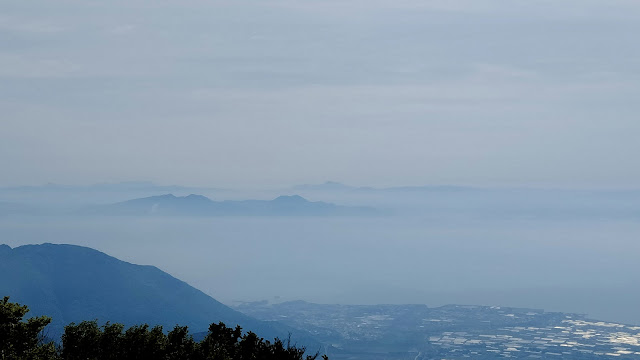 |
| クリック |
長崎は今日も晴れで始まった。車を車庫から出して、荷物を詰め込み雲仙に向かって出発。
長崎郊外の田んぼという田んぼが荒廃して、最早田んぼとして使われていないのを目の当たりにし、日本は今にお米も自給自足できなくなる日が近いのではないかと懸念する。
 |
| 雲仙 |
仁田峠付近の展望台から普賢岳の頂きがちょっと頭を出しているのが見え、その隣に1991年の噴火でできた平成新山が巾をきかせている。新山の山肌を見ると噴出されたゴロゴロした石や、流れ出た溶岩流の跡をはっきり見て取れる。雲仙は温泉町を通り過ぎるとき、硫黄島のにおいが強くし、湯気が噴出していたが、人影は多くなく、往時は勢いのあったであろうホテルが寂しげに立っていた。
口之津港からフェリーで天草の鬼池に向かうが、思っていたより利用者は多く、フェリーはギチギチに車を積んで出発。乗り切れずに次のフェリーを待つ人もでた。学生時代に友達とバスで回った天草に私は殆ど半世紀ぶりに戻ってきた。あの頃の天草は今にも増して秘境、世界の果てという雰囲気のある所だった。今は道路が整備されたが、人口が増えたとは思えない。崎津の教会を対岸から眺める位置で、地元の元船乗りさんと話す。
 |
自分は昭和38年に高校を卒業したが、それからセネガルやマダガスカル付近で漁をする船にのっていたことがあるし、タンカーで駿河湾付近を航海したこともあった、という話からすると彼はエンジニアか?漁師さんではなさそう??今や崎津では3‐4の家族が漁を生業としているのみ。自分が小さい頃は一学年に50人のクラスが2組ぐらいあったこともあったが、今は学校もない。「廃村になるのかな」と寂しそうに、でも「そんなもんさ」といった調子で話す。
この旅で5つ目になるお城、熊本城を外から見る。すでに閉門されている時間。やはり石垣は地震でかなりのダメージを受けていた。崩れた石の一つ一つに番号が付けられお濠に並べられている。その数は膨大で、気が遠くなりそう。私が生きている間に石垣の再生はちょっと無理じゃないかと思う。
We take a nice road down to the harbour of Kuchinotsu, from where we take a ferry to the island of Amakusa. It only takes 30 minutes.
Yumiko remembers something of her journey back then, but we (narrowly) miss our first destination, the mission church in Oe. During the persecution of Christians, Amakusa was the last refuge for many Christians because the island was difficult to reach.
The church is probably the only one where believers pray on tatami mats. We have a long chat with an elderly man from the village, who tells us that "in the past" there were 400 children here.
Nothing is left of it. Four families still live from fishing, the young have long gone and the old are dying. He shrugs his shoulders. That's just the way life is.
Our last destination was the Amakusa Collegio Museum. It is interesting because it tells the story of the "Four Boys", who were the first Japanese ever to be allowed to leave Japan and travel to Rome in 1590 - 1598 as part of a delegation from the Tenno.
This machine "revolutionised" the distribution of printed matter in Japan. Shortly after their return, however, the political situation in Edo changed and one of them was exiled to Macau, for example!










